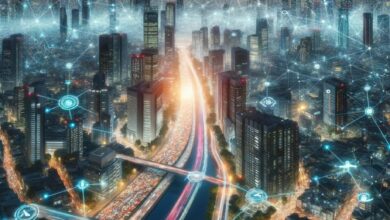
The content of this article has been inspired by the first reference book on Intelligent Automation, which has recently been released.
The Industrial Revolutions started over 200 years ago, automating “blue-collar” work in the agricultural and manufacturing industries. They provided massive and structural benefits to our society, such as the reduction of famine and an increase in standards of living. They also relieved people from laborious manual work.
Officially coined in 2017 by IEEE, Intelligent Automation (IA) ushers in a new revolution: that of office work, automating “white-collar” work. Today, office work accounts for more than 80% of the job roles in our global economy, such as lawyers, financial controllers, or call center operators. Like the previous automation revolutions, I believe IA will have a significant impact not only on employment but, more broadly, on our society.
What is IA?
IA, also called Hyperautomation or Cognitive Automation, is one of the most recent trends in the field of artificial intelligence. It is a combination of methods and technologies, involving people, organizations, machine learning, low-code platforms, robotic process automation (RPA), and more. It is aimed at automating end-to-end business processes in a computerized environment. It delivers business outcomes on behalf of the employees.
For example, IA supports the automation of most work activities in “Procure to Pay”: from the selection of vendors (using machine learning), sending of orders (leveraging workflow platforms), reception and processing of their invoices (with natural language processing), up to the payment of these vendors (with RPA). As a result, IA increases process speed, reduces costs, eliminates errors, and enhances compliance. Ultimately, it improves employee and customer satisfaction and boosts revenues.
How does IA boost business efficiency?
Even though IA has only been coined recently, its applications have spread incredibly quickly in the business world, validating its promise. It has already been adopted by more than 50% of the world’s largest companies, including ADP, JP Morgan, ANZ Bank, Netflix, and Unilever. The expected impact on business efficiency is in the range of 20 to 60%. These benefits are available to all organizations, across industries, and regardless of function.
While impactful, implementing IA is certainly not a silver bullet. While it is easy to succeed in implementing a pilot on a limited scope, many organizations have been struggling to scale their transformations. Successful organizations have followed leading practices, such as the ones described in this article.
IA and COVID 19
In my view, this crisis evidenced the need for more resilient systems to support our society. Our health and economic systems, mainly managed by a human workforce, have been put under extreme stress. Hospitals were desperately in need, while economies were falling into downturns. IA has a large role to play in solving this and make our world ready for the next ones.
“COVID-19 (has) achieved in six to eight weeks what the evangelists of automation have not managed… for more than five years.” Ilan Oshri, Professor at the University of Auckland’s Graduate School of Management.
Despite the bad aspects of Covid-19, it has helped the world understand the importance of digitalizing processes enabling remote performance, and automating them to rely less on the human workforce. Companies that already leveraged IA have been able to continue their operations, collect their cash, manage their operations, and motivate their employees remotely.
How does IA improve employee’s experience?
According to Gallup research, 85% of employees worldwide are not fulfilled by their work, because it is too manual, repetitive, and tedious. IA solves a large part of this issue by freeing up employees from repetitive and transactional tasks (e.g., keying in invoices in an accounting software). And it refocuses them on more value-added and exciting tasks (e.g., the ones involving insights, creativity). It also augments them, transforming them into superhumans able to generate insights from millions of data in a few seconds (e.g., identifying a tumor on an X-Ray in a few seconds).
How does IA boost the customer experience?
Building trust, satisfying and retaining customers is critical for businesses. 96% of unhappy customers don’t bother complaining, and 91% of them will simply leave and never return. IA helps to create innovative and customized products, and highly responsive, omnichannel customer services available 24/7. Based on my experience with IA, companies can increase the level of their customer satisfaction by over 50%, while reducing the contact center workload by over 50%.
How does IA save lives?
IA has the potential to save millions of lives every year by supporting clinical trials and disease diagnosis, and avoiding medical errors. In developing countries, it can help reduce deaths from preventable causes (e.g., 1.6 million people died from diseases related to diarrhea in 2017) and compensate for the shortage of 4.3 million physicians globally, by enabling remote diagnosis. For example, IA application Tissue Analytics instantly diagnoses chronic wounds, burns, or skin conditions just by taking a photo from a smartphone.
How can IA save money, and reallocate it to better uses?
In addition, IA could have the potential to realize a $10 trillion of cost savings yearly, by reducing frauds, errors, and accidents. Indeed, IA not only makes transaction processes more efficient and reliable, but it also generates log files for every action, creating transparency and ease of compliance. Such a vast amount of money would allow us to double our global budget for education, help restore our planet from pollution, or even eliminate hunger!
How can IA help to reinvent our world?
Generalizing the use of IA in our word is not without risks. To prepare our world to effectively translate the key benefits of IA, our societies’ roadmap should include some imperatives.
First, education needs to be adapted to fit the skills expected in the future. It has to focus on people’s competitive edge; that is, on tasks machines will never be able to do (well). In my view, the most crucial of these skills are creativity, adaptability, and “learning how to learn”.
Second, according to economists, the use of digital technologies over the last decades has resulted in increasing wealth inequalities amongst people. To remedy, it seems necessary to consider implementing wealth-sharing mechanisms such as Universal Basic Income.
On top of this, IA’s impact on employment needs to be monitored very closely. Similarly to the previous industrial revolutions, an optimistic scenario holds that IA will enable the creation of more jobs than we have today. Conversely, a pessimistic scenario suggests that, due to the fast pace and other specifics, IA will massively reduce the number of jobs available. While the actual scenario will most likely be hybrid, to mitigate risks, we need to be prepared to deal with both scenarios. We owe this to our children and future generations.
Enabled by the above initiatives, IA could help us consider building a new, more human society. One that involves a new, more engaging definition of “work”, and that would give us the time to refocus on what matters the most in our lives: family, love, taking care of the others, and our planet.




